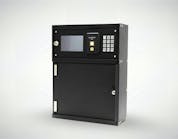Lever locks have been part of the security lineup for many years. Mailbox locks, luggage, cabinet locks and even padlocks once depended heavily on levers as one of the best means for providing security. Lever locks are economical to manufacture and do not require quite the same close tolerances necessary in pin tumbler construction. False gates on levers and boltworks serve to deter any attempt at lock picking.
The amount of key combinations available for lever locks is only limited by the amount of levers being used. Key cuts for lever locks require vertical cuts on the key. Vertical cuts do not cause maximum adjacent cut problems because there is no adjacent material removed. Levers can be stacked into a relatively small area. As example, a lever lock with 6 levers and 8 depths can produce more than 1 million separate key combinations.
While pin tumbler locks have surpassed lever locks for some uses, safe deposit boxes remain a prime lever lock candidate. One good reason for using lever locks for safe deposit doors is the need for a guard key. Both the guard key and renter’s key must be present when a deposit box is to be opened. First, the guard key is inserted and turned. Second, the renter’s key is inserted and turned. If the correct guard and renter’s keys have been inserted, the renter’s key can retract the bolt, allowing the door to be opened.
In cases where the renter’s key is missing, safe deposit lock keyways can usually be either drilled out or pulled using special safe deposit lock nose puller tools. Once the keyway is removed, the levers are usually free to drop out of the locking area and the bolt can easily be withdrawn. Safe deposit locks are normally destroyed in this process, but the safe deposit doors are left intact. This ‘destroy and replace’ system works well, but several lock companies have either gone out of business or discontinued making safe deposit box locks.
BULLSEYE S.D. LOCKS
Bullseye S.D. Locks realized the need for replacement safe deposit locks and now offers an economical line of locks which have the same ‘footprint’ as the original products. In addition, Bullseye can match almost any existing guard key combination, so the new locks can be used along with guard key systems already in the field.
The Bullseye safe deposit lock line includes:
• B400 product group for replacing ILCO A-400, Lloyd Matheson M-40, Miles X-4, Precision P-40 plus S&G 4440 locks.
• Bullseye B500 product group for replacing Precision 5400 and S&G 4500 locks
• B175 product group for replacing Diebold 175-05 locks.
• B5700 product group for replacing Mosler 5700 and Mosler 3175 Rapid Set locks
• Lefebure 7700 product group
• Lefebure 7300 product group
• Kumihira product group
• Miles X-4 product group
In addition, Bullseye offers a kit for Diebold B175 locks so technicians in the field can rekey the guard lock portion to an existing guard key combination. Time locks and plus number plates which are similar to the originals round out the Bullseye line.
SPACING AND DEPTHS
The following information is from original drawings. Measurements may vary depending on the lock manufacturer.
A400/P40 Renter .054 cutter
Spacing: 434-383-332-281-230-179
Depths: 0)320 1)300 2)280 3)260 4)240 5)220 6)200 7)180
A400/Guard .054 cutter
Spacing: 380-329-278-227-176
Depths: 0)280 1)260 2)240 3)220 4)200 5)180 6)160 7)140
P40/Guard .054 cutter
Spacing: 434-383-332-281-230-179
Depths: 0)280 1)260 2)240 3)220 4)200 5)180 6)160 7)140
5400/Renter .054 cutter
Spacing:439-387-335-283-231-179-127
Depths: 0)330 1)310 2)290 3)270 4)250 5)230 6)210 7)190
P57/Renter .088 cutter
Spacing: 686-600-514-428-342-256-170
Depths: 0)375 1)335 2)290 3)245 4)200 5)155
P57/Guard .088 cutter
Spacing: 643-557-471-385-299-213-127
Depths: 0)350 1)319 2)288 3)257 5)226
For more information, visit the following manufacturer web sites:
–Bullseye: www.bullseyesdlocks.com
–Framon: www.framon.com
–HPC: www.hpcworld.com
–Jet: www.jetkeys.com
–Kaba-Mas: www.kaba-mas.com
–S&G: www.sargentandgreenleaf.com





